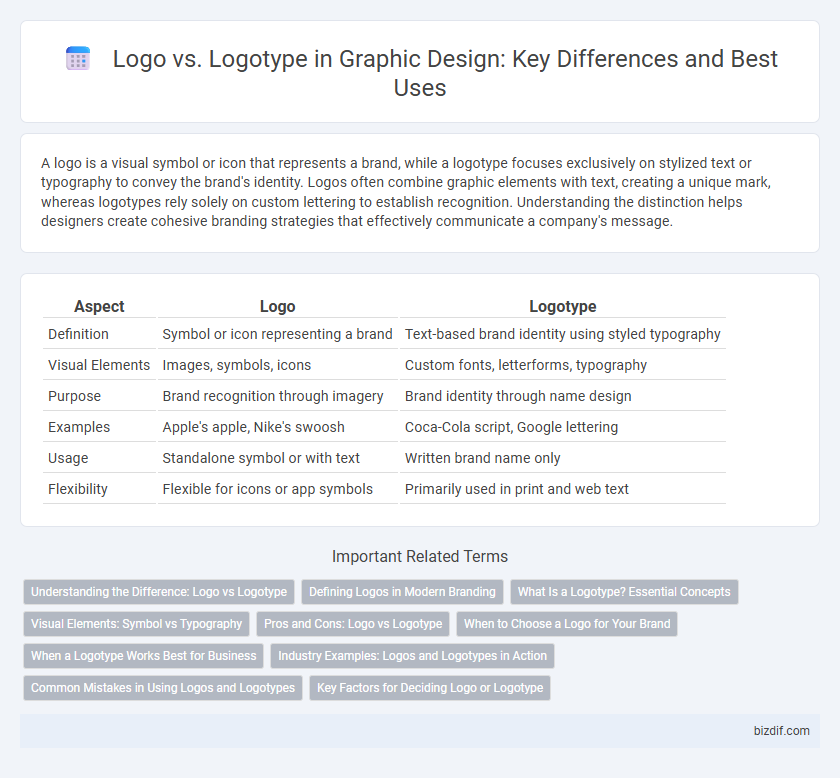A logo is a visual symbol or icon that represents a brand, while a logotype focuses exclusively on stylized text or typography to convey the brand's identity. Logos often combine graphic elements with text, creating a unique mark, whereas logotypes rely solely on custom lettering to establish recognition. Understanding the distinction helps designers create cohesive branding strategies that effectively communicate a company's message.
Table of Comparison
| Aspect | Logo | Logotype |
|---|---|---|
| Definition | Symbol or icon representing a brand | Text-based brand identity using styled typography |
| Visual Elements | Images, symbols, icons | Custom fonts, letterforms, typography |
| Purpose | Brand recognition through imagery | Brand identity through name design |
| Examples | Apple's apple, Nike's swoosh | Coca-Cola script, Google lettering |
| Usage | Standalone symbol or with text | Written brand name only |
| Flexibility | Flexible for icons or app symbols | Primarily used in print and web text |
Understanding the Difference: Logo vs Logotype
A logo is a visual symbol that represents a brand and can include icons, images, or abstract designs, while a logotype specifically refers to a text-based design using the company's name or initials styled with unique typography. Understanding the difference helps businesses choose the most effective branding element for recognition and communication, with logos offering visual identity and logotypes emphasizing name clarity. Both elements play critical roles in graphic design by shaping brand perception and enhancing marketing efforts.
Defining Logos in Modern Branding
Logos serve as the visual cornerstone of modern branding, combining symbols, icons, or typography to encapsulate a brand's identity and values. A logo can be an abstract mark, emblem, or combination mark that conveys the essence of a company at a glance, enhancing brand recognition across digital and physical platforms. In contrast, a logotype strictly involves stylized text or a brand name crafted with unique typography, emphasizing brand name visibility and memorability within competitive markets.
What Is a Logotype? Essential Concepts
A logotype is a unique typographic representation of a brand's name, designed to convey identity and values through custom letterforms and stylistic elements. Unlike a logo that may include symbols or icons, a logotype relies exclusively on text, often creating a distinctive and memorable visual signature. Mastering logotype design involves understanding typography, legibility, and brand personality to craft a cohesive and impactful brand identity.
Visual Elements: Symbol vs Typography
Logo often incorporates a symbol or icon that visually represents a brand's identity, creating immediate recognition through imagery. Logotype relies exclusively on customized typography, emphasizing unique letterforms and font style to convey brand personality. Combining both elements enhances brand memorability by balancing symbolic visuals with distinctive textual design.
Pros and Cons: Logo vs Logotype
A logo, often a symbol or icon, enhances brand recognition through visual impact and versatility but can lack direct verbal clarity. A logotype, consisting solely of stylized text or typography, offers clear brand identification and readability but may lack the immediate visual appeal of a graphic logo. Choosing between a logo and a logotype depends on factors like brand personality, marketing strategy, and the need for visual distinctiveness versus straightforward communication.
When to Choose a Logo for Your Brand
Choosing a logo for your brand is ideal when you want a visually memorable symbol that conveys your brand identity quickly and effectively. Logos work best for businesses seeking broad recognition across various media, providing a flexible and scalable design that captures the essence of the brand in a simple icon or mark. This makes logos particularly useful for startups, lifestyle brands, and companies aiming to establish a strong visual presence in competitive markets.
When a Logotype Works Best for Business
A logotype works best for businesses seeking a clear and memorable brand identity through customized typography that directly communicates the company name. It is particularly effective for startups or companies with unique or pronounceable names, as the stylized lettering enhances brand recognition and consistency across marketing materials. Using a logotype simplifies design applications, ensuring versatility in both digital and print media while reinforcing brand recall.
Industry Examples: Logos and Logotypes in Action
In graphic design, logos like Nike's iconic swoosh serve as powerful visual symbols, while logotypes such as Coca-Cola's script rely on distinctive typography to establish brand identity. Industry leaders like Apple utilize a simple logo mark to convey innovation, whereas Google's logotype emphasizes custom lettering to showcase approachability and clarity. Businesses often blend logos and logotypes to create versatile branding solutions that enhance recognition across digital and print media.
Common Mistakes in Using Logos and Logotypes
Confusing logos with logotypes often leads to inconsistent brand identity, as logos represent graphic symbols while logotypes focus on stylized text. A common mistake is modifying a logo's proportions or colors, which undermines brand recognition and reduces visual impact. Overusing complex logotypes without clarity compromises readability, especially in smaller sizes or digital formats.
Key Factors for Deciding Logo or Logotype
Choosing between a logo and a logotype depends heavily on brand identity, target audience, and scalability needs. Logos prioritize symbol recognition and visual impact, whereas logotypes emphasize typography and brand name clarity. Key factors include industry relevance, memorability, and adaptability across digital and print platforms.
Logo vs Logotype Infographic

 bizdif.com
bizdif.com